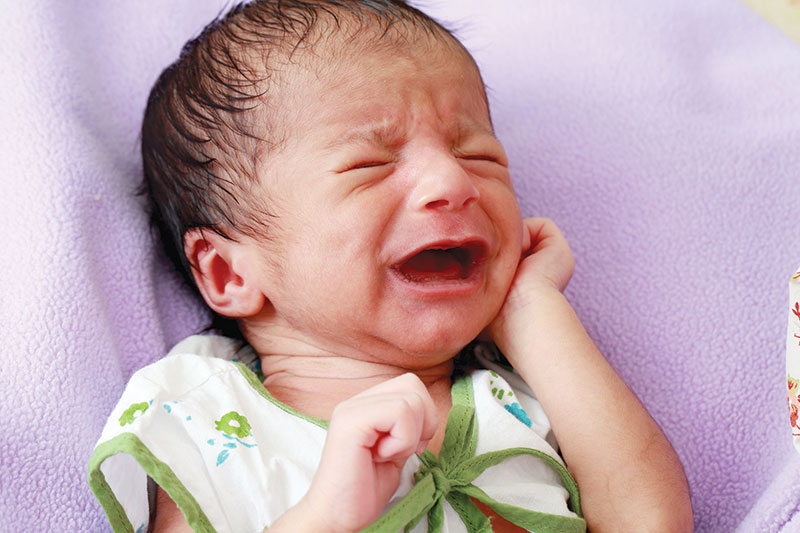Assessing and addressing pain in infants
Infants aged below a year vocalise illness or discomfort through loud and continuous crying. This often nerve-racking din can disturb the most stoic caretaker and frustrate parents about ways and means to diagnose and address the pain – Dr. Gita Mathai

Most paediatricians divide children with ailments into three groups — infants under age one who cannot verbalise their symptoms; toddlers who can state their symptoms but are unable to localise the pain they feel, and last, young semi-adults who are articulate, lucid and cooperative. In this essay let’s focus on infants and toddlers.
Infants below age one vocalise illness or discomfort through loud and continuous crying. This nerve-racking din can disturb even the most stoic caretaker and frustrate parents about ways and means to assess and address the pain and causative ailment. For instance a simple problem such as blocked nose can prompt continuous wailing as the only way the infant is able to breathe is by crying — mouth breathing does not come naturally to new-borns.
 The most common ailments of infants are colic, ear and abdominal pain. Ear pain can be unbearable and excruciating for new-borns. In such cases if you gently press the ear or pull or tug at it, you may be able to localise the pain, and address it.
The most common ailments of infants are colic, ear and abdominal pain. Ear pain can be unbearable and excruciating for new-borns. In such cases if you gently press the ear or pull or tug at it, you may be able to localise the pain, and address it.
Colic
Infants aged two-four months tend to suffer colic. Typically, colic is identified by loud inconsolable bouts of crying for three hours or more at least three days a week for three weeks or more. The din usually begins in the evening.
There are many home and OTC (over the counter) remedies for infantile colic, such as bonnisan, gripe water, simethicone drops and home-made jeera water. It’s best not to use any of them. Some contain opioids, others alcohol and in some, the ingredients are not mentioned.
Instead try carrying the baby on your shoulder, and patting her on the back. The colic usually disappears as suddenly as it appeared.
Abdominal pain
The other most likely cause of discomfort within infants is abdominal pain. The pain originates from hollow organs such as the stomach or intestines if they are stretched. The stretching may be due to constipation, twisting or torsion which disturbs the blood supply to the abdominal organs.
Infections such as those of the urinary tract, diarrhoea or dysentery can also cause painful tissue inflammation in the abdomen and intestines. Moreover, one of the intestines can slide into the other and get obstructed, a condition called intussusception. However this has become less common as many children now receive rotavirus immunisation.
The abdomen, which contains all the digestive organs, including the stomach, small and large intestines, pancreas, liver, and gallbladder, is richly supplied by nerves which enter the spinal cord from both sides and at multiple levels. This interplay of nerves makes it difficult for adults to accurately localise pain, let alone a child. Generally, pain from the oesophagus and stomach is felt in the upper abdomen, small intestine in the umbilicus, and that from the large bowel, bladder and kidney in the lower part of the abdomen. However it’s not unusual for children to consistently point to the umbilicus as the centre and root cause of pain. Many parents misconstrue this as appendicitis which is very rare in children under age two.
The abdominal organs are covered with a tissue known as the peritoneum. If it is inflamed, many nerves carry the “feeling of pain” to different areas of the skin. The pain tends to be localised, sharp and intense and aggravated by coughing and sneezing.
It’s also likely that pain which appears to be localised in the abdomen may actually arise from other areas such as the chest. Pneumonia and pleurisy may manifest as abdominal pain, causing confusion. Therefore watch out for other systems such as high fever and rapid breathing, which foretell pneumonia.
Stomach ache is a common complaint in children. Most of the time, it is temporary and not a cause for concern. It may be due to gastroenteritis, food poisoning, flatulence, indigestion or even hunger. Recurrent abdominal discomfort may also be a sign of food allergy, particularly to cow’s milk.
Stomach pain needs to taken seriously if
» The infant cannot be distracted or comforted
» There is diarrhoea or blood and mucous in the stool
» Abdomen swells up
» Vomiting
» Fever
» Coughing or breathing is different
» Difficulty in urination
» Rash, itching or some other form of visible allergy
It is difficult to localise and diagnose abdominal pain in children of all ages, because of their faulty, unreliable perception and localisation. Therefore a great deal depends on the observation and expertise of caregivers. It is better to be safe than sorry and consult a paediatrician, who is trained to identify, diagnose and treat abdominal pain.
Please don’t rely on the advice of elders and self-styled experts. Sometimes recurrent abdominal pain in children confounds even experienced doctors and tests and scans are required before an accurate diagnosis is made and treatment begun.
(Dr. Gita Mathai is a Vellore-based paediatrician and author of Staying Healthy in Modern India)














Add comment